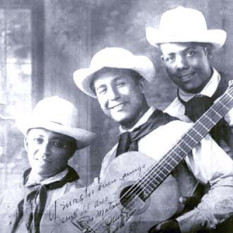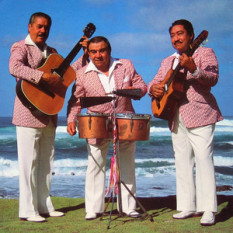Many musicologists consider this band as the most genuine exponent of the Cuban Son as well as one of the greatest interpreters of traditional Cuban music.
At the beginning, when the band was formed in 1920 'septeto' was in truth a 'sexteto'. The group was formed by Guillermo Castillo, Felipe Nery Cabrera and Gerardo Martinez. Current leader, German Pedro Ibanez says that the only difference in their present music is that now they have microphones :)
In 1927 the Habanero were the first ones to incorporate brass into their lineup, when their trumpeter, Enrique Hernandez, joined the band (making it into septeto).
Hernandez din't last long - shortly after his arrival he was replaced by famous Felix Chappotin. Thanks to him today it is difficult to imagine the son without the trumpet.
By 1925 the band was invited to New York to record for the prestigious Victor label, records that would become huge hits back in Cuba.
The regime of Gerardo Machado brought the first crisis for the soneros - the dictator considered their music subversive and began imprisoning musicians. In one way his actions helped - thanks to him Habanero became more popular when they escaped Machados' clutches.
With the vocals of Gerardo Martinez and the trumpet virtuoso Felix Chappotin, Habanero released more and more hit records. In the 1940s and 50s, the band regularly performed live concerts direct from Havana's radio studios. In 1952, vocalist Manolo Fure joined the septeto. In 1958, while on his deathbed Martinez passed the Habanero leadership mantle on to Fure, who held the post until 1995 when guitarist/composer Pedrito Ibanez took over leadership from the then ailing Fure.
Today, there are actually eight players in Ibanez's Habanero, but they retain the original septeto instrumentation. Three singers: Gonzalo Emilio Moret Lupe (who also plays the guiro), Digno Marcelino Perez Martinez (maracas), and Jose Perez Arregoitias (claves), plus Felipe Ferrer Caraballo (tres), Ricardo Vidal Ferro Vicente (bongo), Faustino Sanchez Illa (double bass), and Servando Arango Garcia (trumpet).
To say that Septeto Habanero is busy would be an understatement. Within Cuba, Habanero regularly perform 15-25 concerts a month. Few bands, anywhere in the world, even young musicians, let alone a bunch of guys that in most places would be retired, have as much work. They also continue a busy international touring schedule.
In 1997, Septeto Habanero's work caught the ear of Lusafrica's Jose da Silva, the renowned Paris based Cape Verdean producer. In the 1990s, Da Silva brought Cesaria Evora to worldwide stardom with a series of now classic productions. In November 1997, da Silva brought Ibanez's Septeto Habanero into Havana's fabled EGREM studios. The result, "Orgullo de los Soneros." features the acoustic septeto's trademark sound reminiscent of the early part of the century recorded with a state of the art production. The repertoire includes nine compositions by Ibanez and lead singer Gonzalo Emilio Moret Lopez, plus four arrangements of some old Habanero classics.
"Things have changed quite a bit over the course of the century," reflects Ibanez. "Take the second track, "Se Entero" for example. It is a Lucumi song (Lucumi is the Yoruba-African religion in Cuba). This type of African music was totally unacceptable by the government, high society, and even the middle class back in the 20s. Today our music is respected at the highest level."
based on and borrowed from Dan Rosenberg's article .
All albums
You can find information through the best music search engine - Muzlan.top 😊All materials on request "Septeto Habanero" are available on page Septeto Habanero
Yes of course. You can listen tracks on the page Septeto Habanero
Yes of course. You can download tracks on the page Septeto Habanero
This page is found by queries: Septeto Habanero all mp3, Septeto Habanero song listen, Septeto Habanero mp3 download, Septeto Habanero flac, Septeto Habanero track minus


